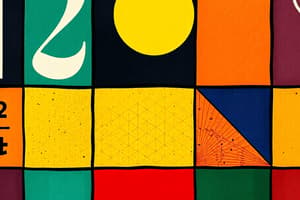Podcast
Questions and Answers
Which branch of mathematics is most directly concerned with the rate of change of a function?
Which branch of mathematics is most directly concerned with the rate of change of a function?
- Geometry
- Statistics
- Differential Calculus (correct)
- Algebra
A researcher wants to analyze the effectiveness of a new drug using data collected from a clinical trial. Which branch of mathematics would be most applicable?
A researcher wants to analyze the effectiveness of a new drug using data collected from a clinical trial. Which branch of mathematics would be most applicable?
- Statistics (correct)
- Number Theory
- Calculus
- Geometry
In cryptography, which mathematical field provides the foundation for secure communication protocols?
In cryptography, which mathematical field provides the foundation for secure communication protocols?
- Calculus
- Abstract Algebra (correct)
- Geometry
- Topology
A city planner needs to optimize the layout of roads to minimize traffic congestion. Which mathematical field might they use for modeling and analysis?
A city planner needs to optimize the layout of roads to minimize traffic congestion. Which mathematical field might they use for modeling and analysis?
Which of the following best describes the primary focus of topology?
Which of the following best describes the primary focus of topology?
What is the primary purpose of using variables in algebra?
What is the primary purpose of using variables in algebra?
Which mathematical concept is fundamental to both differential and integral calculus?
Which mathematical concept is fundamental to both differential and integral calculus?
In number theory, what is a central concept related to the divisibility of integers?
In number theory, what is a central concept related to the divisibility of integers?
When evaluating the arithmetic expression $5 + 3 \times 2 - 1$, which operation should be performed first according to the order of operations?
When evaluating the arithmetic expression $5 + 3 \times 2 - 1$, which operation should be performed first according to the order of operations?
What is the purpose of using coordinate systems in analytic geometry?
What is the purpose of using coordinate systems in analytic geometry?
If a function's output is always the same regardless of the input, how would you best describe it?
If a function's output is always the same regardless of the input, how would you best describe it?
Which mathematical tool is most commonly used for visualizing sets and their relationships?
Which mathematical tool is most commonly used for visualizing sets and their relationships?
What is the primary focus of linear algebra?
What is the primary focus of linear algebra?
A software engineer needs to design an algorithm to efficiently search through a large dataset. Which area of mathematics would be most relevant?
A software engineer needs to design an algorithm to efficiently search through a large dataset. Which area of mathematics would be most relevant?
Which of the following tools is essential for using algebraic techniques to solve geometric problems?
Which of the following tools is essential for using algebraic techniques to solve geometric problems?
How are sine, cosine, and tangent primarily used in trigonometry?
How are sine, cosine, and tangent primarily used in trigonometry?
Which branch of mathematics provides the theoretical foundation for understanding computer algorithms and data structures?
Which branch of mathematics provides the theoretical foundation for understanding computer algorithms and data structures?
What is the fundamental theorem of calculus used for?
What is the fundamental theorem of calculus used for?
Which task uses combinatorics?
Which task uses combinatorics?
Which area of mathematics focuses on rigorous definitions and proofs related to calculus topics?
Which area of mathematics focuses on rigorous definitions and proofs related to calculus topics?
Flashcards
What is Mathematics?
What is Mathematics?
The science and study of quantity, structure, space, and change.
What is Arithmetic?
What is Arithmetic?
Oldest and most elementary branch of mathematics, involving basic operations on numbers.
What is Algebra?
What is Algebra?
A generalization of arithmetic using symbols to represent numbers and quantities to create equations and inequalities.
What is Geometry?
What is Geometry?
Signup and view all the flashcards
What is Calculus?
What is Calculus?
Signup and view all the flashcards
What is Trigonometry?
What is Trigonometry?
Signup and view all the flashcards
What is Statistics?
What is Statistics?
Signup and view all the flashcards
What is Discrete Mathematics?
What is Discrete Mathematics?
Signup and view all the flashcards
What is Number Theory?
What is Number Theory?
Signup and view all the flashcards
What is Topology?
What is Topology?
Signup and view all the flashcards
What is Mathematical Analysis?
What is Mathematical Analysis?
Signup and view all the flashcards
What is Logic?
What is Logic?
Signup and view all the flashcards
What is Set Theory?
What is Set Theory?
Signup and view all the flashcards
What is Abstract Algebra?
What is Abstract Algebra?
Signup and view all the flashcards
What is Linear Algebra?
What is Linear Algebra?
Signup and view all the flashcards
What is Combinatorics?
What is Combinatorics?
Signup and view all the flashcards
Study Notes
- Math is the science and study of quantity, structure, space, and change.
- Mathematicians seek out patterns, formulate new conjectures, and establish truth by rigorous deduction from appropriately chosen axioms and definitions.
Arithmetic
- Arithmetic is the oldest and most elementary branch of mathematics.
- It deals with basic operations on numbers: addition, subtraction, multiplication, and division.
- More advanced operations include exponentiation, root extraction, and logarithms.
- The order of operations (PEMDAS/BODMAS) is crucial for evaluating arithmetic expressions correctly.
Algebra
- Algebra is a generalization of arithmetic, using symbols to represent numbers and quantities.
- It allows for the formulation of equations and inequalities, which can be solved to find unknown values.
- Key concepts include variables, coefficients, constants, and algebraic expressions.
- Polynomials are a fundamental part of algebra, consisting of terms with variables raised to non-negative integer powers.
- Linear equations and systems of linear equations are a significant area of study.
Geometry
- Geometry is concerned with the properties and relations of points, lines, surfaces, solids, and higher dimensional analogs.
- Euclidean geometry, based on Euclid's axioms, is the standard for plane and solid geometry.
- Analytic geometry uses algebraic techniques to study geometric objects, often using coordinate systems.
- Trigonometry relates the angles and sides of triangles, and is essential for many applications.
- Differential geometry studies the geometry of curves and surfaces using calculus.
Calculus
- Calculus deals with continuous change and is divided into two main branches: differential calculus and integral calculus.
- Differential calculus concerns derivatives and rates of change.
- Integral calculus concerns integrals and the accumulation of quantities.
- The fundamental theorem of calculus links differentiation and integration.
- Calculus is used extensively in physics, engineering, economics, and other fields.
- Limits and continuity are foundational concepts for calculus.
Trigonometry
- Trigonometry is the study of the relationships between the angles and sides of triangles.
- Sine, cosine, and tangent are the primary trigonometric functions.
- Trigonometric identities are equations that are true for all values of the variables.
- The unit circle provides a visual representation of trigonometric functions.
- Trigonometry is used in surveying, navigation, and other fields.
Statistics and Probability
- Statistics is the science of collecting, analyzing, interpreting, and presenting data.
- Descriptive statistics summarize and describe the main features of a dataset.
- Inferential statistics use sample data to make inferences about a population.
- Probability is the measure of the likelihood that an event will occur.
- Probability distributions describe the probabilities of different outcomes in a random experiment.
Discrete Mathematics
- Discrete mathematics deals with mathematical structures that are fundamentally discrete rather than continuous.
- Logic, set theory, graph theory, and combinatorics are major areas within discrete mathematics.
- Discrete mathematics is essential for computer science.
Number Theory
- Number theory is the branch of mathematics that deals with the properties and relationships of numbers, especially integers.
- Prime numbers, divisibility, and congruences are central concepts.
- Famous problems in number theory include Fermat's Last Theorem and the Riemann Hypothesis.
Topology
- Topology studies the properties of spaces that are preserved under continuous deformations, such as stretching, bending, crumpling, and twisting, but not tearing or gluing.
- Point-set topology (general topology), algebraic topology, and differential topology are major subfields.
Mathematical Analysis
- Mathematical analysis is a branch of mathematics that deals with the rigorous study of calculus and related topics.
- Real analysis and complex analysis are major subfields.
- Topics include sequences, series, limits, continuity, differentiation, integration, and functions.
Logic
- Logic is the study of reasoning and argumentation.
- Propositional logic and predicate logic are two main branches of formal logic.
- Logical fallacies are common errors in reasoning that can invalidate an argument.
Set Theory
- Set theory is the branch of mathematics that studies sets, which are collections of objects.
- Basic operations on sets include union, intersection, and complement.
- Venn diagrams are used to visualize sets and their relationships.
Abstract Algebra
- Abstract algebra studies algebraic structures such as groups, rings, and fields.
- These structures are defined by sets of elements and operations that satisfy certain axioms.
- Group theory is used in physics, chemistry, and computer science.
Linear Algebra
- Linear algebra deals with vector spaces, linear transformations, and systems of linear equations.
- Matrices and determinants are fundamental tools in linear algebra.
- Eigenvalues and eigenvectors are important concepts for understanding linear transformations.
Combinatorics
- Combinatorics is the study of counting, arrangements, and combinations of objects.
- Permutations and combinations are fundamental concepts.
- The binomial theorem and Pascal's triangle are important tools in combinatorics.
Studying That Suits You
Use AI to generate personalized quizzes and flashcards to suit your learning preferences.




